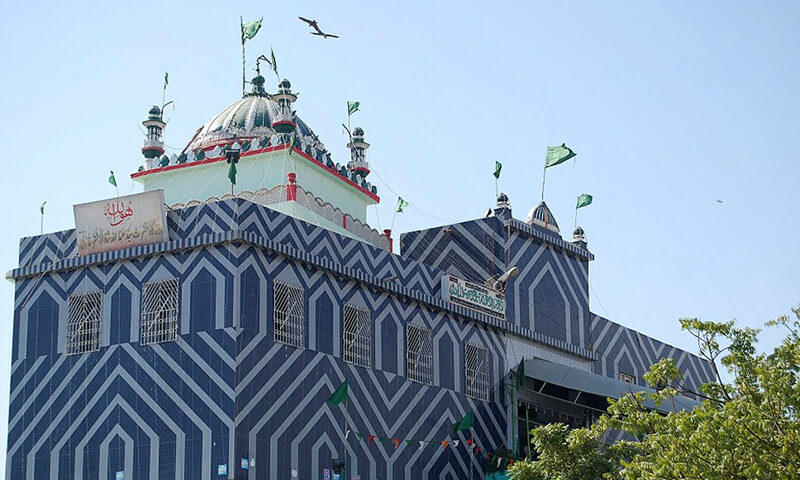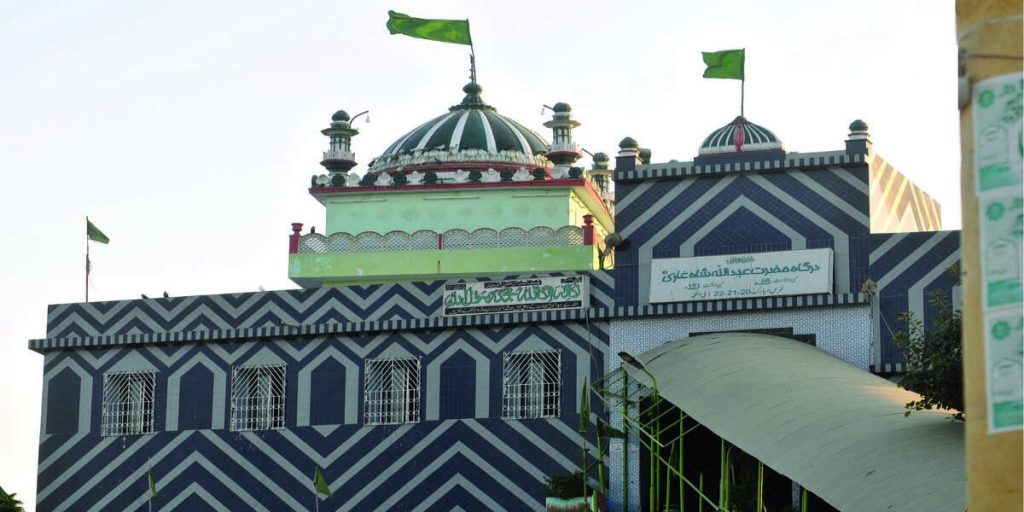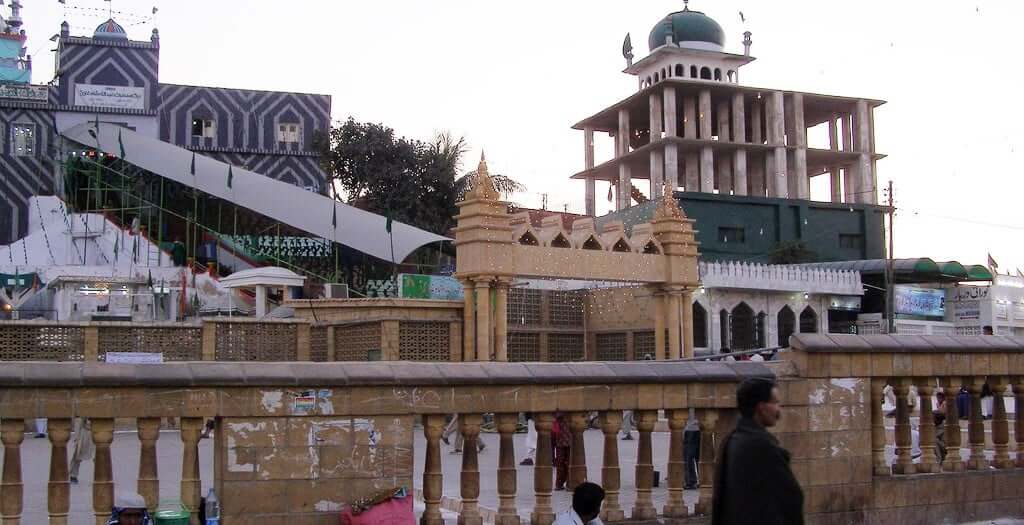Abdullah Shah Ghazi Shrine
Karachi has many monuments, memorials, and shrines, one of the biggest is Abdullah Shah Ghazi Shrine in Clifton. Those who live near Jehangir Kothari or Jehangir Kothari can easily see. The shrine is a large overshadowing monument whose base is decorated with flower shops. The entryway follows a line of steps that take you to the main shrine chamber, distinctive by an unmistakable beautiful green dome. It is a popular Karachi attraction. Abdullah Shah Ghazi Shrine is loved to see the place by locals, travelers, visitors, and its caretakers. The site is thoroughly kept clean all the time and is significantly developed in contrast with its surroundings. The spot is visited by countless people throughout the year, especially on Thursdays when the number of guests increases by a higher degree.
Intro About Abdullah Shah Ghazi Shrine
The green dome was placed on the 19th-century building more than a hundred years ago. The sanctuary is the entombment place of Abdullah Shah Ghazi. He is one of Pakistan’s most adored and revered Sufis and is mainly well-known in Sindh’s territories. Abdullah Shah Ghazi was born on 109 Hijri. He was born in the 8th century and came to Karachi during the Ummayad line’s rule. At that time, they considered his presence a threat to their rule. They attacked him in 151 Hijri, which is why he is today regarded as a great martyr. There are many stories among locals about his coming to Karachi, the manner of his death, his martyrdom, etc. About ten centuries have passed now since this incident.
Abdullah Shah Ghazi Shrine Karachi Attractions, Timings & Locations
How the Shah Gazi shrine is built is very, unique. It is unlike any other shrine in Karachi. So it is not easy to place this unique in any particular category. This fact alone has been the cause of prime attraction for many people who come from far away places to visit this complex and beautiful shrine. Today the shrine is very different from the original mausoleum in which it was constructed. A lot of changes have been made.

One of Karachi’s most famous metropolitan legends is connected with the sanctuary of Abdullah Shah Ghazi, the most significant shrine in Karachi. They are based on the city’s sandy shores nearly ten centuries prior, as the last resting spot of a Sufi holy person, Abdullah Shah Ghazi. From the mid-twentieth century, the crowds coming to respect the resting place of the Sufi increased. Many people still believe they feel the soul of the Sufi present in the shrine, and this belief draws many still through stories. Numerous Karachiites dismiss such convictions; however, even now, various individuals in this city are persuaded that Shah Ghazi’s soul remains Karachi’s best defense against typhoons and destruction.
History of Abdullah Shah Ghazi
Till the mid-1950s, the hallowed place was only a tiny, little hovel on top of a sandy slope in what we currently know as the Clifton View region in Karachi. The shrine only had a little or some significant image of what it resembled long before it was first appropriately reconstructed and altered in the 1940s and afterward in the mid-1950s by a renowned person, creator, and scholar Zia Mohyeddin.
Abdullah Shah Ghazi’s sanctuary draws in Muslims and Christians and Hindu people in groups to pay their respects. One of the city’s preeminent planners and students of history, Social Lari, proposes that Shah Ghazi was a Bedouin dealer who had come to Sindh with the main rush of Middle Easterner trespassers. Be that as it may, one more noted history specialist, M. Daudpota, recommends that Ghazi appear nearby from Iraq as an officer who, alongside Muhammed Bin Qasim, battled Sindh’s Hindu ruler, Raja Dahir, long ago.
He got comfortable in Sindh and started living there alongside his sibling, Syed Misri Shah, and turned into a supporter of the Sufi sect of Islam. After some time inside Sindh, his enemies captured and killed him. The supporters he had assembled conveyed his body to the shores where he had first come to Sindh. They buried him on top of a slope close to the area from where he had shown up on a Middle Easterner boat. This region currently lies nearby Clifton and Ocean View in Karachi.
The minuscule sanctum kept drawing committed Ghazi enthusiasts (both Muslim and Hindu) for a long time. It started to be extended and improved during the 1960s by Ayub Khan, mainly after it drew in considerably higher numbers of people. Of the enormous number were the ordinary people who began to move to Karachi from nearby communities and towns in Punjab, Sindh, and Khyber Pakhtunkhwa. Before long, an entire culture of celebrations, music (Qawalli and dhamaal), and little shops started arising around the place of worship.

The Z.A. Bhutto government (1971-77) further extended the hallowed place. It became Karachi’s biggest Sufi sanctuary, drawing in Muslim people and individuals from the city’s Christian and Hindu communities and groups. However, the shrine continued to be a well-known, respected spot for the city’s steadily developing regular workers and lower-working class sections (of all nationalities and religions). Still, it was generally ignored by the traditionalist Ziaul Haq government (1977-88). It started to look poor and in dire need of fixes. Around the area, many unlawful activities began to well up, from selling drugs to petty crimes. In 2005, the regional government headed by the Muttahida Qaumi Development (supported by the Musharraf government) began a broad fix, tidying up and redesigning work on the sanctuary, which was finished in 2007.
One more exciting aspect that a person can relate to the shrine is that many people who visit it are Urdu-speaking and Punjabi. Most Sindhis saw Shah Ghazi as a forceful trespasser who used the fight against the ancestors of the Sindhis. According to a few nationalists, Sindhis were enthusiasts of the Sufi holy people, for example, Lal Shahbaz Qalandar and Shah Abdul Lateef, because they showed up in the area as serene Sufis.
Shah Ghazi might have been a hero turned Sufi. Yet, his shrine was forced to surrender in 2010 by angry people who thought that Sufism is not according to Islamic beliefs and not relatable to the true meaning of religion. Be that as it may, the hallowed place faced brutal acts. It keeps drawing in many working people and lower-working class Karachiites, the city’s impoverished and the oppressed who find comfort here.
To these people, Shah Ghazi embraces all. All aside from tornadoes.
The exact location of Abdullah shah ghazi Shrine Clifton is R26J+788, Block 4 Block 3 Clifton, Karachi, Karachi City, Sindh. You can visit any time during the day or in the evening. It is better to leave in the morning if you are not in the vicinity to arrive at the shrine earlier than most people, saving a lot of time for the return journey.
The Architecture of Abdullah Shah Ghazi Shrine
The shrine is more than 1000 years old. It was first conceived of as a shrine by the followers of the Sufi saint Shah Gazi who buried him there after his death. Architectural advances have only been made recently. The mausoleum was not considered a shrine for the more significant part of its history. The dome was added by the end of the last century. All the additional construction work was done over the years by the government of Pakistan under different presidents. The architecture of the shrine in its current form is alluring and unique.
The tomb is based on a high base at the ground level. The body is built-in underground. The shrine has a tall, square chamber and a green-and-white striped dome, improved with Sindhi tilework, flags, and buntings. Admirers of the shrine stroke the silver railing around the internment spot and wrap it with laurels of blossoms. The shrine is profoundly respected and regarded by individuals of all nationalities and religions.

Until the mid-20th century, the shrine was a little hovel on a sandy slope in Clifton. The shrine was fabricated and extended by Syed Nadir Ali Shah, a Sufi holy person of Lal Shahbaz Qalandar, former overseer of the shrine. The famous dome of the shrine, the windowed wandering, the Mosque, the free kitchens or Langar Khana, the Qawwali court, the pilgrim hold up on its premises, and the long flight of stairs prompting the shrine were worked under his supervision. The shrine has been a focal point of fascination for individuals having a place with various factions, nationalities, and segments of society. Free dinners and reflective verse readings, for example, Qawwali, are prominent elements of the shrine. In 1962, the Auqāf division took its managerial control. In 2011, the shrine was given over to a Pakistani developmental giant famous for its advanced construction and architectural works, Bahria Town, which redesigned the outside of the shrine. This got a mixed reaction from the occupants of Karachi. The Abdullah Shah Ghazi shrine was a target of a bomb attack once, which ended up killing ten and harming 50. The terrorists did not conform to the Sufi philosophy and took it as an insult to Islam, and they claimed to have been protecting the religion from Sufis.
Instructions to be followed at the shrine
For people visiting for the first time, it is essential to remember the history of this revered and sacred place. So to understand it, you need to follow the instructions based on the respect people have for this place. It is kept very clean due to the consideration of its sanctity, so you need to take notice of cleanliness when you are on the premises of the shrine. If you have children with you, you have to discipline them when you are inside. The children like to run and play around with themselves often and could disrespect the shrine somehow. So it would be best if you told the children about the Importance of the shrine so that they can be respectful themselves and learn appropriately about the significance of the shrine.
Importance of Shrine
The Importance of the shrine lies in its profound historical Importance. Without understanding the historical significance, you cannot understand the shrine’s Importance. Around 761, Muhammad Nafs al-Zakiyah cruised from Aden to Sind, where they talked with the lead representative, Umar ibn Hafs Hazarmard, before returning to Kufah and Medina.
His child Abdullah al-Ashtar, otherwise called Abdullah Shah Ghazi, married a lady from Sindh and had children with her. Ibn Khaldun and Ibn al-Athir say that the lead representative.
Attractions and Facilities at Abdullah Shah Ghazi Shrine
The shrine has many attractions, which is why the place is hugely attractive to many people. The shrine has a big courtyard that can accommodate many people simultaneously. The area is revered and respected by all visitors because of its religious significance, so it is maintained clean and presents a peaceful and fresh environment. The primary purpose of people’s visit is to respect the reverential Sufi of Islam. The tomb of Abdullah shah ghazi is the greatest attraction of all people who visit here. Here the courtyard presents the same space for rich and poor people. Everyone who visits is equal under the same roof of the holy place. The pilgrim’s spot also houses the poor and rich equally. One of the other most alluring aspects of the shrine is the chilla gah and chasma, both considered holy and revered by those who are not even directly concerned with them. The faith of devotees remains with the people; even after knowing so little about the obscure history, they still respect the place out of its historical and religious significance. Umer Sharief is also buried here, which many visitors do not know. There are many underground caves inside the shrine which are genuinely knowledgeable about the shrine, among other things. As previously mentioned, the place is ancient, and people could have used caves early on. After the bomb attack, the complete security of the shrine was increased. There is also a mosque inside for prayer and a visitor parking facility.
Annual Urs Festival
Each year from all over Pakistan, hundreds of Pakistanis come to the shrine for Urs, which is an annual festival. The URS marks the true Importance of the shrine; the religious celebrations invoke the holy spirit of each visitor. The food is distributed freely to the homeless and poor during such events.
Abdullah Shah Ghazi Shrine Timings
The shrine is always open, and the homeless can find shelter here too. You can visit any day or any time and will be welcomed by everyone.
Location of Abdullah Shah Ghazi Shrine Clifton
The shrine is located in Clifton in Karachi, Sindh province of Pakistan. R26J+788, Block 4 Block 3 Clifton, Karachi, Karachi City, Sindh.
FAQs
Who is Buried in Abdullah Shah Ghazi Mazar?
Besides the famous Sufi martyr Abdullah shah ghazi, Umer Sharief is also buried here.
What is Abdullah shah ghazi famous for?
Abdullah shah ghazi was a Sufi mystic of classical Islamic antiquity. He was born In 720 AD and died in 773 AD. He was 52 years old when he died. His martyrdom made him famous among the devotees of Islam and Sufism.
Conclusion
These are the important events before the Sufi martyr’s arrival, giving the place its historical significance. Sohail Lari, a historian, says that Shah Ghazi was a Middle Easterner trader who had come to Sindh with the main rush of Bedouin victors. Nonetheless, one more noted history specialist, M. Daudpota, proposes that Ghazi appeared nearby from Iraq as an officer who, alongside Muhammad ibn al-Qasim, battled Sindh’s Hindu ruler, Raja Dahir. Abdullah Shah Ghazi was said to have been killed near Sindh by his foes. As mentioned above, the advocates of the Sufi buried him in this place, currently known as the shrine along the Clifton shores. Every true Pakistani should visit the Mizaar because of its historical and religious significance.
